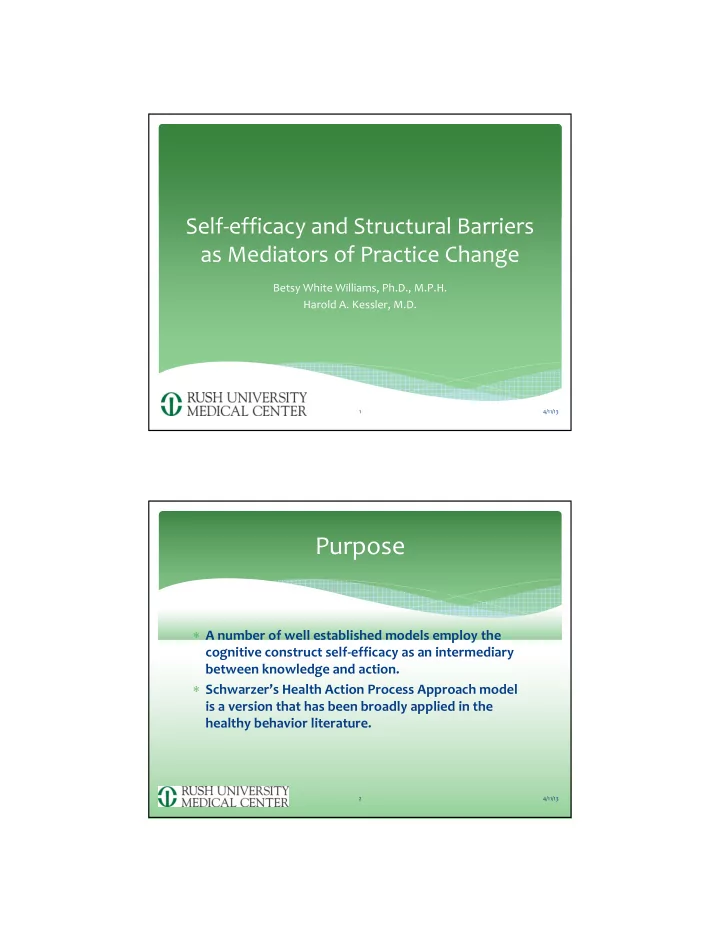

Self-efficacy and Structural Barriers as Mediators of Practice Change Betsy White Williams, Ph.D., M.P.H. Harold A. Kessler, M.D. 1 4/11/13 Purpose ∗ A number of well established models employ the cognitive construct self-efficacy as an intermediary between knowledge and action. ∗ Schwarzer’s Health Action Process Approach model is a version that has been broadly applied in the healthy behavior literature. 2 4/11/13
HAPA Here Self- efficacy is seen as acting both directly on Intention as well as on Planning 3 4/11/13 We had been working with Barriers ∗ We had been working with barriers to implementation of some of our programs ∗ Interestingly when the group of learners was split into two groups – one to work on medical technical issues and one to work on barriers to implementation ∗ We received roughly twice the compliance from the medical technical group ∗ It was as if the learners simply were uncomfortable in dealing with non-medical barriers 4 4/11/13
We decided to study the constructs more formally ∗ In a large group of learners we decided to assess the relationships among the three cognitive constructs: ∗ Intent ∗ Self-efficacy ∗ Barriers to change 5 4/11/13 Method – Self-efficacy Scale ∗ Method: The measure of individual sense of self-efficacy was a four- item scale purpose built for CME. As considerable work has been done in this area the wording borrows heavily from Schwarzer’s scale. ∗ The four items were: ∗ I find that it is difficult to translate information from scientific meetings to direct patient care ∗ I succeed in changing patient regimens and my clinical practice according to the latest available data. ∗ Typically changing patient regimens has not been as successful as I would like. ∗ I am as able to change my practice patters in response to new data as my colleagues. 6 4/11/13
Barriers Scale ∗ The measure of barriers was a seven-item scale that was also purpose built. As we have been studying this for some time we employed the scale we have used in the past. ∗ My patient mix is appropriate for the strategies ∗ My office and practice systems can accommodate these changes ∗ My patients will have trouble complying with these changes/strategies ∗ These changes are too time consuming ∗ I am so comfortable with my current approach it will be difficult to change ∗ My current office and practice systems are very difficult to change ∗ The Medications/procedures discussed are not available for my patients 7 4/11/13 Method ∗ Each of these measures has been confirmed for structure and together they provide indicators of four underlying variables – two self-efficacy variables and two barrier variables. ∗ In addition, a global intent to implement measure was collected using a 5 point Likert scale. ∗ 150 respondents are in the dataset 8 4/11/13
Methods - Variables ∗ For the preliminary analysis we employed the derived variables (the factor scores ) from these two sets of variables: ∗ Self-efficacy related to change ∗ Self-efficacy related to past results ∗ Barriers related to organizational structure ∗ Barriers related to interpersonal inertia 9 4/11/13 Results Structural ∗ Results: Preliminary analysis demonstrates a significant relationship between the variables Inertial ∗ The overall model explains Intent approximately 60% of the variance Change ∗ The univariate relationships between the two barrier constructs and intent appear significant. Result 10 4/11/13
Self-efficacy and Barriers ∗ Further inspection of the Structural relationships finds that Change the sense of self-efficacy related more specifically Inertial to change is itself related to the perception of barriers. ∗ The model explains about 30% of the variance in barriers 11 4/11/13 Our Preliminary Model ∗ Unlike the HAPA model, our Structural results suggest that barriers to implementation mediate the effect of self-efficacy in Inertial Intent these data ∗ Our results also find a much less significant effect for Change result related efficacy Result 12 4/11/13
The overall analysis shows a significant relationship ∗ Specifically the sense of efficacy in effecting change in the practice environment, a sense of structural barriers to change, as well as, the sense of personal and staff resistance to change are predictive of formation of an intent to change practice patterns. ∗ The self-efficacy construct, however, appears to manifest in the sense of the barrier rather than directly in the formulation of intent. 13 4/11/13 Conclusion ∗ Inspection of the barriers constructs suggests that they mediate the self-efficacy constructs’ effect on intent. ∗ The relationship between self-efficacy and intent to change appears to be related to the participants’ sense of the impediment caused by the barrier at question. ∗ The proximal barrier completely masks an important underlying causal relationship that ultimately contributes to effective practice improvement through CME. 14 4/11/13
Next Steps ∗ Several issues need to be studied further. ∗ A full model with all observed variables included needs to be tested and confirmed; ∗ The two instruments, while serviceable, could do with strengthening; and, ∗ An experimental manipulation to fully demonstrate the causal relationships needs to be attempted. 15 4/11/13
Recommend
More recommend